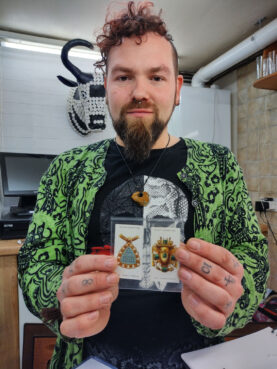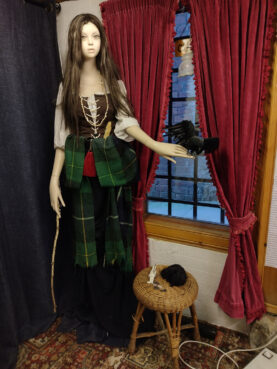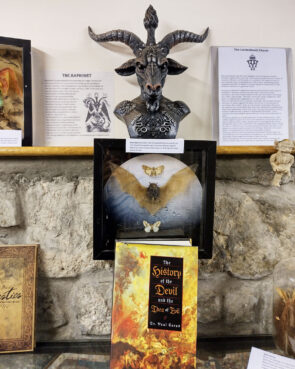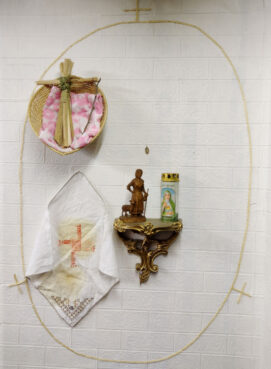EDINBURGH, Scotland (RNS) — Just off of Royal Mile in Old Town Edinburgh, in a 17th-century stone building on Chalmers Close, is a new museum that, though dedicated to a part of history most Scots might like to forget, raises questions that remain relevant in the country and the world today.
At the new Museum of Magic, Fortune-telling and Witchcraft, visitors can gawk at a mummified cat as well as good-luck charms once used by ordinary Scots. Also on display are mystical amulets and bottles once owned by those thought to be witches.
“Scotland has had a long history of magic and witchcraft, which goes way beyond Harry Potter. I wanted to highlight this magical heritage,” said Ash William Mills, the museum’s founder and a historian of Scottish witchcraft and magic who has authored three books on the subject.
But Mills said he had a more pressing reason: to urge Scots to reckon with a dark and much-forgotten period in Scottish history. The country’s Witchcraft Act, passed in 1563 and in law until 1736, granted license to brutally torture, persecute and punish ordinary people perceived as witches. In a population of about 1 million, nearly 4,000 people were accused and 2,500 executed for witchcraft under the act — roughly five times the European average at the time.

Museum founder Ash William Mills hopes the museum will allow people to learn more about an often unacknowledged history of witchcraft in Scotland. Photo by Sukhada Tatke
“My main aim was to bring awareness to the persecution of innocent men and women. I wanted to show how the paranoia and panic spread,” said Mills, 35, who worked for a year to get the museum up and running.
Many of the museum’s artifacts are from Mills’ personal collection, which he began collecting in his 20s. Some objects were donated by people who had inherited them. Many were found inside walls or under floorboards, where they were kept for safety.
The museum’s opening earlier this year came close on the heels of historic apologies by two major Scottish institutions. Last year, on International Women’s Day, Scotland’s then first minister, Nicola Sturgeon, acknowledged the “egregious historic injustice” by extending a “formal posthumous apology to all of those accused, convicted, vilified or executed under the Witchcraft Act of 1563.” Two months later, the Church of Scotland followed suit.
The witch trials in Scotland were in line with a larger hysteria that had gripped Europe following the publication in 1486 of a treatise called “Malleus Maleficarum,” or “Hammer of the Witches,” by two German monks. The work underlined the detection of witchcraft and its ablation. In post-Reformation Europe, Protestants and Catholics were trying to assert their own godliness by stamping out that which was considered “ungodly” and evil. So-called witches were caught in the crossfire.
According to the Survey of Scottish Witchcraft, a University of Edinburgh database created by historians and researchers, there were five flashpoints of witch panic in Scotland: 1590-91, 1597, 1628-30, 1649 and 1661-62.
The first major panic, in 1590, began shortly after King James VI of Scotland had sailed home from Copenhagen with his new bride, Anne of Denmark, through a fierce storm. The violent waves almost killed James and the queen.
Convinced this had been the work of witches intent on his ruin, he embarked on a witch hunt in North Berwick, close to Edinburgh. Nearly 70 innocent people were tried and tortured, some burnt at the stake. A pamphlet that hangs on the wall of the new museum, “Newes from Scotland” detailed the entire trial.
Also on display is “Daemonologie,” the book James published in 1597, a kind of manual on how to spot and prosecute witches, accusing them of “high treason against God.” “He started off chapters with, ‘I am ordained King by God, and therefore I am speaker of God Himself,’” said Mills.
But witchcraft was also commonly believed and even practiced in many Scottish homes. Take, for instance, the witch bottle that Scots used for centuries before the witch hunts. Filled with one’s urine, pins, needles, strands of hair or even shards of glass, it was believed that the bewitched person had a psychic link to the witch, which could be thwarted by these bottles. An example of a witch bottle, found inside a wall in Cheshire and dating to the 1600s, is one of the oldest items in the museum.
Though the word magic may not have been used, practitioners of witchcraft remained widespread into the early modern period, said Julian Goodare, emeritus professor of history at the University of Edinburgh and director of the website “Survey of Scottish Witchcraft.” He was speaking on the podcast “Witches of Scotland,” hosted by Claire Mitchell, King’s Counsel, and writer Zoe Venditozzi, founders of the advocacy group by the same name that is working toward a pardon and a memorial for the witches.
These practitioners commonly cured people of their illnesses, made prophesies, carried out rituals and ceremonies and assumed the role of matchmakers by performing love magic. They used charms, spells and devices to counteract bad luck.

A mannequin holding a crow is part of a series helping understand the early roots of witchcraft in Scotland. Photo by Sukhada Tatke
“Bad magic,” on the other hand, was believed to be carried out after quarrels among neighbors. If you argued with a neighbor and the following day your cow did not give milk, you convinced yourself that the neighbor had cursed you. Goodare said matters were usually resolved through negotiations and reconciliations.
Things changed when the Witchcraft Act was put in place and lawmakers and legal authorities entered the picture. “This is when the idea came along that the witches had sold their souls to the devil, were dancing and having sex with him. People believed that the devil was real and working black magic,” said Mitchell, of the “Witches of Scotland” podcast.
Almost 84% of those accused of witchcraft were women, many unmarried or widowed and therefore without any protection. Witch hunts were as much about scapegoating of people who were “different” as they were about condemning women. “It was a terrible miscarriage of justice, and because there has not been enough emphasis on women’s history, it is forgotten. Battles and wars fought by men got recorded but not this,” said Mitchell.
The group Remembering the Accused Witches of Scotland’s website lists supposed signs of witchery that were as far-ranging as they were ludicrous. “Do you talk to animals? This could be taken as you talking to a demon or another witch who had shape shifted. Do you have a mole, freckle, skin tag, or birth mark? This could be seen as having the mark of the devil and as proof that you had given your soul to him by renouncing your baptism.”
The journey from accusation to persecution was rather straightforward. Neighbors took each other to court, which sometimes meant the church. The accused were then tortured by devices like thumbscrews, scold’s bridles, iron collars, often in public spaces. Sleep deprivation was the most common form of torture.

Witchcraft is present in Scottish folklore past and present and has continued to inspire conversation with things like books and figurines. Photo by Sukhada Tatke
“They were asked leading questions while being tortured and made to confess about their pact with the devil,” said Mitchell. They were first strangled, then burnt at the stake.
In time, the persecutions were put under more scrutiny. “There were many questions about the ways in which people were identified as witches,” said Margaret Malloch, professor in sociology, social policy and criminology at the University of Stirling and the head of learning resources at RAWS. “Witch hunters were fraudulent, so the realization came that individuals were executed on false evidence,” she said.
Malloch said the resonances with modern-day persecutions are uncomfortable. “Even now, there are groups and individuals with no power who are marginalized and scapegoated. There are many parallels between justice and injustice historically and contemporarily. It is why we cannot forget this history,” said Malloch.


